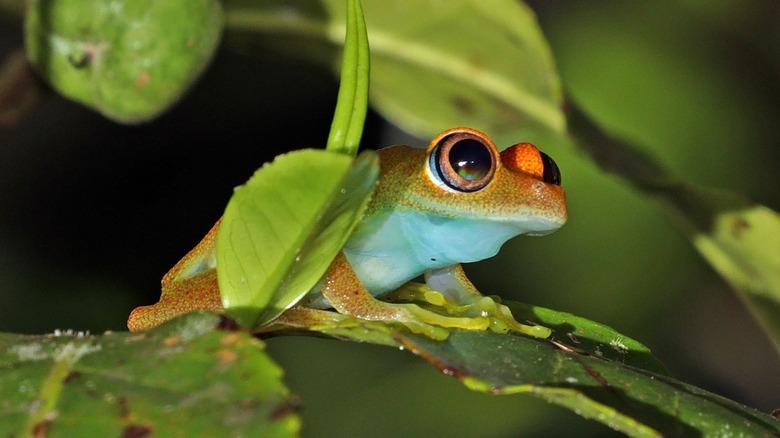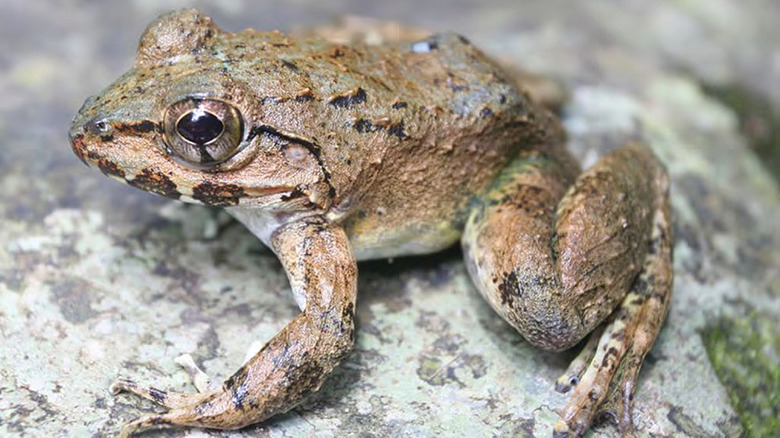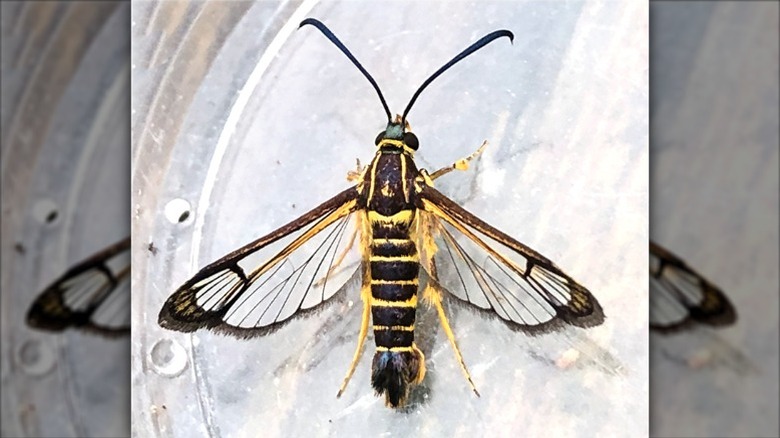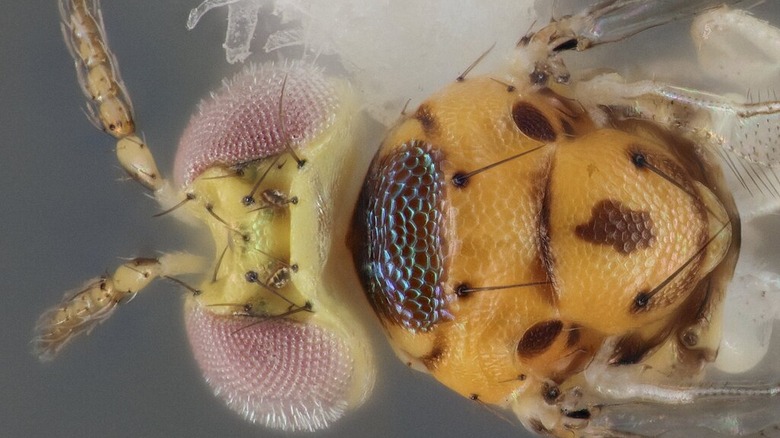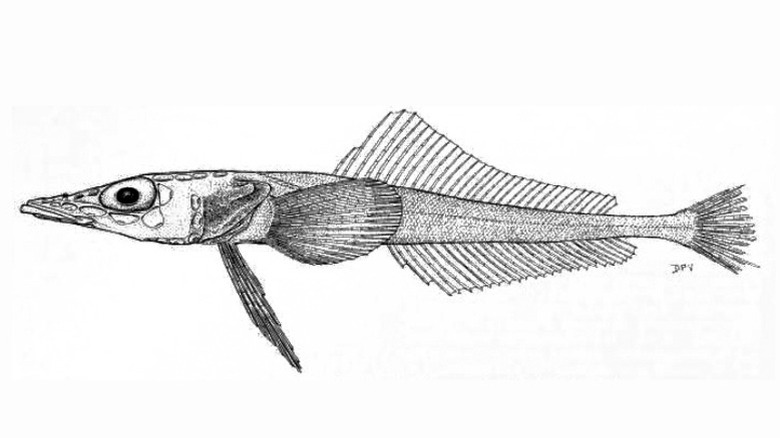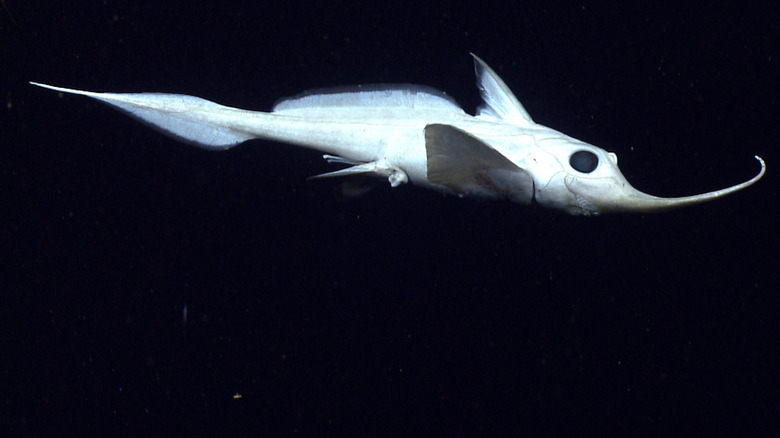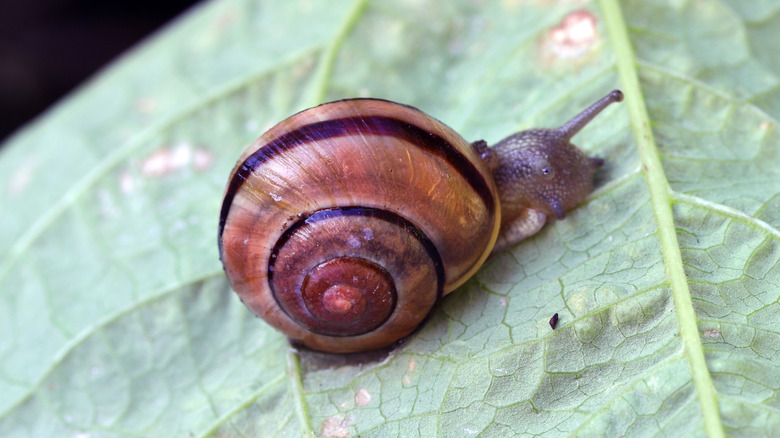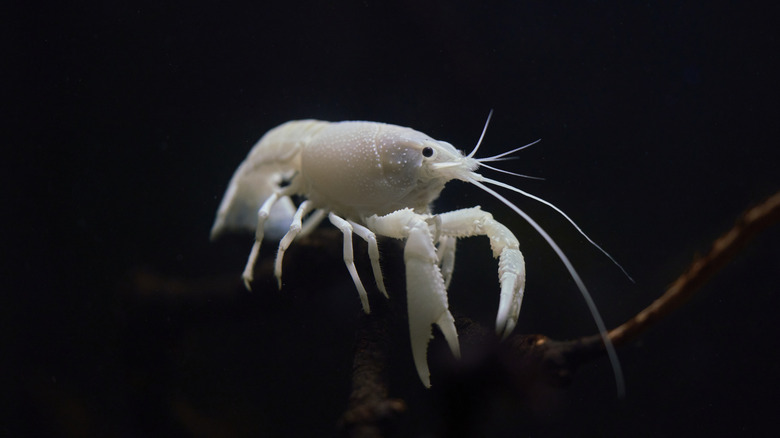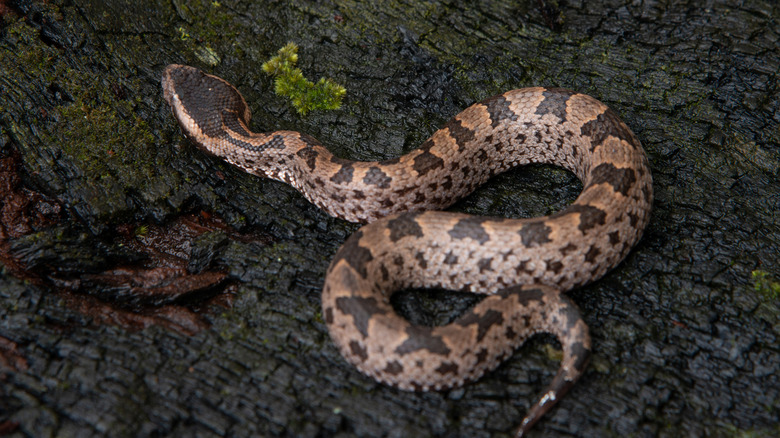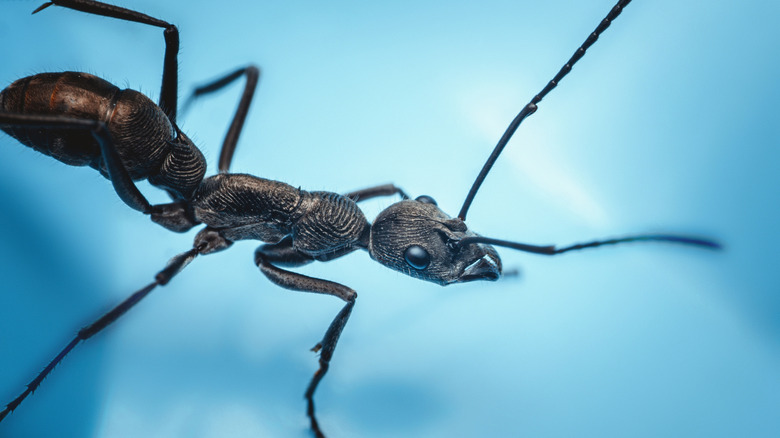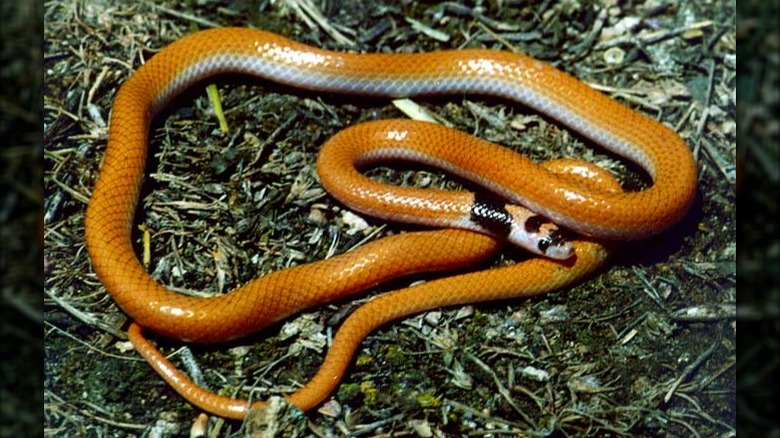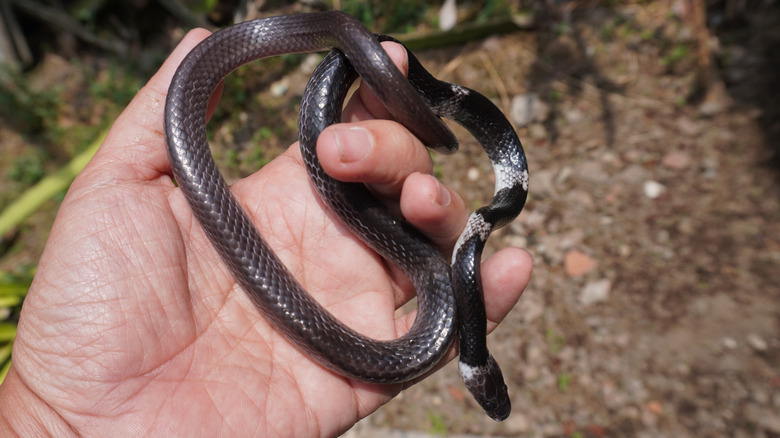13 New Animal Species That Were Discovered In 2024
Despite our ability to populate almost all parts of the world, Mother Nature is still pretty good at keeping a few secrets from humans. But with every new trek into uncharted rainforests or further into the depths of the seas, we're still able to meet animals that are totally new to us. 2024 was a fantastic year for new discoveries in the animal kingdom, and you can keep reading on to see 13 of the most striking of them. This baker's dozen of new species run the gamut, from frogs named in homage to iconic television to truly terrifying-looking fish, and we're breaking down everything we now know. So grab your critter keepers and magnifying glass because it's time to go exploring.
Boophis, the Star Trek frogs
Deep in the rainforests of Madagascar lives a species of frog that's truly out of this world. The University of Copenhagen announced in October 2024 that an international team of researchers discovered seven new species of frogs from the Boophis genus. Their calls, which sound like whistling, reminded researchers of sound effects from "Star Trek," leading to each species being named after an iconic character from the series: B. kirki (Captain Kirk), B. picardi (Captain Picard), B. siskoi (Commander Sisko), B. janewayae (Captain Janeway), B. archeri (Captain Archer), B. pikei (Captain Pike), and B. burnhamae (Admiral Burnham).
These new treefrogs live in the more mountainous regions of Madagascar near streams. While most European frogs croak, these Boophis frogs emit a high-pitched whistle to attract mates. Researchers believe this distinct call could be to advertise their location to potential mates over the loud roars of the fast-flowing water they like to hang around. Unfortunately, not much time is left for us to learn more about them; climate change is disrupting their microhabitats at a speed that's hard for scientists to compete with. The researchers who discovered this new frog species are hopeful that these new frogs will help bring more conservation efforts into the region so that they, and other species, may live long and prosper for years to come.
Grumpy dwarfgoby
Move over, Grumpy Cat, because there's an ill-tempered-looking fish who's coming to take your spot. The Grumpy dwarfgoby (Sueviota aethon) was discovered in the Red Sea by a joint venture of researchers from the King Abdullah Univesity of Science and Technology and the University of Washington. While it's only 2 centimeters long, don't be fooled by its small stature because it's got a set of canines that most likely strike terror in its neighbors and prey.
Found swimming in the coral reefs in the northern part of the Red Sea, the scientists who discovered it originally thought they were seeing a Fiery dwarfgoby (Sueviota pyrios), already known to science. However, they began to notice a few distinct differences: shorter pelvic fins, a protruding lower jaw, and a lack of tell-tale spots, all of which made them realize this was an entirely new fish species. The Grumpy dwarfgoby's lower jaw makes it look like it's frowning, hence the name. Inside that irritated expression are four elongated teeth scientists believe are for catching prey. Besides what they've gleaned from the six specimens captured, little else is known about the life of S. aethon, and researchers are hoping further diving expeditions can reveal more about this fascinating, crabby-faced fish.
Limnonectes cassiopeia, a new giant fanged frog
The newly discovered Boophis frogs aren't the only new species on the block. In September 2023, researchers from the University of Kansas published new findings that they had stumbled upon a new type of fanged frog living in the mountains of the northern Phillippines. Interestingly, specimens of this frog were already captured and thought to be a juvenile version of the Luzon giant fanged frog (Limononectes macroephalus). However, genetic testing revealed they had a whole new species on their hands, Limnonectes cassiopeia.
What makes L. cassiopeia distinct from its cousin are its five smaller, white toe pads (macroephalus' pads are gray), which were an instant giveaway to herpetologists studying the frog. Once this characteristic was found, scientists were astonished to find out they'd been knee-deep in L. cassiopeia for years. This species of giant fanged frog isn't rare in its native habitat and can often be found living around densely-populated towns on the island. Its species name, Cassiopeia, comes from its aforementioned white toe pads, which lead author Mark Herr said reminded him of the constellation; thus, its name was created.
Carmenta brachyclados, a new clearwing moth
It's not that strange to find new species in places we've previously thought of as fully known. What is strange, though, is finding a new species halfway around the world from its native habitat. Yet Welsh ecologist Daisy Cadet did just that, discovering a new clearwing moth, Carmenta brachyclados, hanging out in her house some 4,500 miles from the moth's home territory.
Cadet noticed the moth because it didn't look like the common house moth typically found around U.K. homes, so she asked her mother, a professional photographer, to take a picture of it. Cadet then uploaded the pic to social media, piquing the interest of moth enthusiasts who referred her to experts at the Natural History Museum. Lepidoptera experts Mark Sterling and David Lees, assisted by Museum employee Jordan Beasley, went through an exhaustive search of over 13 million moth species housed at the Museum, only to find out via DNA sequencing that this was a species never before seen. Based on its genetic profile, Sterling and Lees realized it was a type of Carmenta moth native to Central and South America.
So how did this moth end up nearly 5,000 miles away from home? Cadet's mother had traveled to Guyana on a photography assignment and wore a pair of work boots that were covered in mud during her trip. In the mud were two intact pupal casings, meaning this moth inadvertently brought a friend, too. Both specimens were found, which amazed researchers who already knew clearwings to be notoriously difficult to find. Yet Daisy's mother somehow brought two hardy stowaways back, adding a new layer of the impossible to the story.
Chrysonotomyia susbelli, a new wasp
Rice University, located in Houston, Texas, is home to Scott Egan and his team. What makes Team Egan interesting is that they're responsible for discovering 18 different species in a decade, making them akin to some sort of animal sleuth super group. 2024 was no different for the team, discovering a new wasp species right on their home campus. Dubbed Chrysonotomyia susbelli, this wasp is one of only six yet discovered in its genus and the only wasp found to date that can act as a parasite to gall wasps.
C. susbelli is only one millimeter long and lives in tumor-like growths of its host wasp, Neuroterus bussae. It was confirmed as a new species via microscope studies, which identified its unique characteristics, and DNA sequencing. This discovery just goes to show you that there are untapped worlds closer to home than you might think and that your backyard might be holding more secrets than buried acorns from squirrels.
Akarotaxis gouldae, the banded dragonfish
Deep in the waters off the western Antarctic peninsula lives our next new fish friend. In 2024, researchers from William & Mary's Batten School of Coastal & Marine Sciences and Virginia Institute of Marine Science (VIMS) were trawling for zooplankton off the peninsula's coast. What they found instead were larvae of a dragonfish, which they believed to be from the known species Akarotaxis nudiceps. Yet, ever the researchers, they decided to test the DNA of the larvae just to make sure. That's when they discovered that double-checking is always a good idea, because they had stumbled on an entirely new species of dragonfish, which they named the Banded Dragonfish (Akarotaxis gouldae).
A. gouldae's species name is an homage to the recently decommissioned research and supply vessel Laurence M. Gould and its crew. The banded dragonfish is not as terrifying as its cousin, the deep-sea dragonfish, a species of fish with terrifying teeth, and it's distinguishable by two distinct bands on its sides and grows to around 131 millimeters as an adult. It appears to have a very distinct habitat, living around a depth of 700 meters for adults and between 215 and 964 meters for juveniles. This relatively shallow depth for young dragonfish is a problem as that's prime territory for krill fisheries to cast their nets, grabbing the larval fish before they're strong enough to swim further below. Scientists are concerned that its rarity and small territory mean its population may be endangered, but more exploration of the area and its biodiversity is needed.
Harriotta avia, the narrow-nosed spookfish
Deep in the waters off Australia and New Zealand lives a smooth-skinned ghost shark discovered right in time for Halloween. The National Institute of Water and Atmospheric Research (NIWA) announced in September 2024 that Dr. Brit Finucci, a scientist in their Fisheries department, had stumbled on a new species of shark living on the ocean floor: the Australasian narrow-nosed spookfish (Harriotta avia).
The species name, Avia, means "grandmother" in Latin and was named in homage to Dr. Finucci's grandmother, who had supported her scientific work throughout the scientist's career. But its meaning is also a nod to the prehistoric age of ghost sharks, which some could describe as "grandparents" to contemporary fish species. What makes it distinct from other ghost sharks is its elongated, narrow snout, pectoral fins, and trunk, as well as its large eyes and chocolate brown coloring. Not much is known about its lifestyle or population density yet, as ghost sharks typically reside on the ocean's floor at a depth of around 2,600 meters.
Figuladra robertirwini L. Stanisic, the Robert Irwin's banded snail
You may have had a rivalry with your siblings, but did it ever get so far that it completely changed a branch of science? Robert and Bindi Irwin, children of the famous conservationists Terri and the late Steve Irwin, have done just that. There were already three snails named in homage to Steve, Terri, and Bindi, and in 2024 Robert finally got a snail of his own: Robert Irwin's banded snail (Figuladra robertirwini).
Doctors John and Lorelle Stanisic are credited with the discovery of F. robertirwini, as well as completely revising the taxonomy process for the genus thanks to their research and methods for DNA cataloging. F. robertirwini is one of the larger striped land snails found in Queensland, Australia, with brown ombre or banded shell patterns. Further research needs to be done to determine its genealogy, and not much is known about its habitat just yet. Crikey steveirwini, Protolinitis terriirwinae, and a species of charopid land snail are additional snails named in homage to the Irwin family.
Dulcibella camanchaca, a predatory crustacean
When you hear the phrase "uninhabitable," you probably think, well, that something is uninhabitable. Yet the Atacama Trench off the northern Chile coast is so deep and its pressure is so crushing that it was thought of for years as uninhabitable. But as Jeff Goldblum has taught us time and time again, life (uh) finds a way. Late in 2024, his words rang true again when scientists discovered animals living in that hadal zone, including the first-ever predatory crustacean living quite comfortably amongst the pressure and darkness, Dulcibella camanchaca.
D. camanchaca's description and appearance make it seem right out of a Lovecraft story. It's only 4 centimeters long but swims astonishingly fast in its hunt for prey. It scoops up smaller amphipods with specialized appendages described as "raptorial" by the Woods Hole Oceanographic Institution, just in case it hadn't begun to haunt your nightmares yet. Despite its ghostly appearance and terrifying-sounding lifestyle, scientists are thrilled at its discovery because it proves there's abundant plant and animal life even in the depths of the deepest hadal zone. Sweet dreams?
Ovophis jenkinsi, a new mountain pit viper
You know how it feels on those days when everything is irritating, and you feel like you're about to explode at the first conflict? Imagine living that every day of your life — because that's how it sounds this newly-discovered snake likes to live. Ovophis jenkinsi was recently discovered in an area of China that's become a hotspot of biodiversity discoveries, but it won't be winning any congeniality contests any time soon. It's a slow-moving pit viper with an absolutely monstrous temper, striking out at the slightest disturbance.
Named in honor of herpetologist Robert "Hank" William Garfield Jenkins, O. jenkinsi has only been found in Yingjiang county, China, leading herpetologists to believe it's endemic to the area and a snake that's adapted to living comfortably in the forests. It's small, only averaging around 516 millimeters as an adult, and it's distinguished by its deep orange-brown or brownish-gray markings on its head and dorsal areas, with a dark brown trapezoid pattern down its body. While specimens were collected in 2023, it was identified as a new species in 2024. Interestingly, it seems this is another species that's not bashful, as researchers claim they've had no problem finding more specimens during their treks through the Chinese rainforests. To date, no records show it biting a human, but it's considered so ornery that it's probably best not to test that theory.
Paraparatrechina neela, a new blue ant
Despite us referring to Earth as a blue planet, the color blue is uncommon in plants and even rarer in animals. So imagine the surprise researchers in northeastern India felt when they came across a bright blue ant chilling out in an active village. Yet there Paraparatrechina neela was, in all of its cool-pigmented glory, just waiting to be discovered by science.
Entomologists from Ashoka Trust for Research in Ecology and the Environment (ATREE) and the University of Florida discovered the species, naming it "neela," the word for "blue" in most Indian dialects. P. neela is a small species of ant less than 2 millimeters long and distinguished by a striking metallic or iridescent blue pigment on its body. It was found in a village over 800 meters above sea level, making it even rarer in its genus, which typically lives in areas below that. Scientists aren't yet sure why its coloring is so deeply blue but think it might help in communication or camouflage.
Rhynchocalamus hejazicus, a new snake
In the Hejaz region of Saudia Arabia lives a secretive snake whose discovery unlocks a key answer that has vexed researchers for years. But Rhynchocalamus hejazicus, a small, nocturnal snake only recently discovered, has become a missing piece of a herpetological puzzle, filling in a previous distribution gap that left researchers scratching their heads. However, its shy nature and adaptability are making it difficult for scientists to learn much more than what they already know.
Before the discovery of R. hejazicus, little was understood about why there didn't seem to be any snakes living between the coasts of Yemen and Oman to the Levant. But when a team of scientists from the Centro de Investigação em Biodiversidade e Recursos Genéticos (CIBIO) and Charles University stumbled across this snake in the sandy and rocky regions of this previously thought of no man's, er, snake's land, they knew their research had only begun. R. hejazicus is not easy to come across, so not much is known about its lifestyle. What we do know is that its coloring is usually brown with a black face mask or all black (known as the melanistic morphotype), it's primarily nocturnal, and has no issue living in areas disturbed by humans. The discovery of R. hejazicus has excited researchers in the area because it shows there's still lots more to discover in the region and areas thought to be deadzones are teeming with more life than we know.
Lycodon neomaculatus, the Indochinese banded wolfsnake
New animal discoveries show up in a variety of ways. For some, discovery happens when researchers track and find a new species in its native habitat. For others, it's realizing the species has been hiding in plain sight all along. That's the complicated story of the Indochinese banded wolf snake (Lycodon neomaculatus), a snake that's had an identity crisis in the taxonomical world for nearly 150 years.
The story is a little fuzzy, but it seems to go something like this: In the 1890s, a new snake was discovered in South America, and it was considered a new species of Asian wolf snake, Lycodon subcinctus. Researchers later realized that the name was a bit of a misnomer, so they updated and expanded the snake's description to make it fit. What that seems to have done is create a giant category of Asian wolf snakes worldwide, enveloping different species under one taxonomy, including a "slender" species. But researchers began to wonder about this slender species, so they began to search for it in Indochinese rainforests and lowlands. After finding a few specimens, they made use of the importance of DNA molecules, analyzing the genetic material and realizing it wasn't L. subcinctus, but a new species altogether. Thus, L. neomaculatus was created.
L. neomaculatus is a non-venomous, nocturnal snake about two feet in length with white bands and coloring that varies from black to gray, or dark brown. Scientists believe it mostly feeds on amphibians and lizards, though it may go after the occasional small snake or bird. Its species name, Neomaculatus, comes from the Greek word "neo," for new, and the Latin word "maculatus," meaning "blotched," as a nod to its messy taxonomy history.

